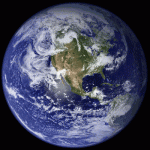 How many people live on this planet? When I was born, there were about 3 billion of us sharing space. Since that time, our numbers have grown to eclipse the 7 billion point. For a lot of reasons, human population is experiencing exponential growth. Since infinite growth within a closed system is not sustainable, the elemental question of just how many of us can this planet support becomes entirely relevant.
How many people live on this planet? When I was born, there were about 3 billion of us sharing space. Since that time, our numbers have grown to eclipse the 7 billion point. For a lot of reasons, human population is experiencing exponential growth. Since infinite growth within a closed system is not sustainable, the elemental question of just how many of us can this planet support becomes entirely relevant.
A Little History
For tens of thousands of years, humans experienced a relatively stable population. Over time, our tool making abilities and hunting/fishing skills progressed to the point that we were able to feed ourselves and migrate over vast distances. By the time the agricultural age began approximately 10,000 years ago, there were about 5 million humans. To put that into perspective, if you took ~65% of New York City’s population in 2010 and scattered them all over the planet, you’d have the entirety of human existence. There really weren’t very many people prior to us discovering how to grow and tend to crops that feed us.
By the time 1804 rolled around, our numbers had exploded to 1 billion people. Two billion rang out in 1927. The year before I was born, we hit 3 billion. Fast forward to 1999 and that population doubled to 6 billion. And we added another billion just 12 years later in 2011, somewhere around Halloween.
Fuelling Population Growth
The first obvious reason for the rapid increase in our numbers came from the shift from a hunter/gatherer society to one that incorporated formal agriculture. Agriculture enabled us to feed more of us, build permanent shelters that protected us from both predators and elements, and establish a social structure that invited greater stability.
The industrial age and the development of technologies derived from the use of fossil fuels greatly accelerated our population growth. These technological advancements also featured discoveries that enabled us to better preserve our health and well-being. Over the last 120 years, our ability to cure disease, administer emergency health care and reduce infant mortality have all conspired to not only improve our fertility numbers, but to reduce the number of deaths along the way. We’re giving birth to more numbers, losing fewer children, and we’re almost all globally living longer.
Is There A Tipping Point?
The current birth/death rates would indicate that we’re actually in a state of overall reduced population growth. Our numbers are still increasing, but only by about 1.1% per year. (I italicized only because if we look back 10,000 years, the growth rate from 8,000 BC to 1 AD was ~0.05% per year.) Back around 1963 or so, our population growth peaked at ~2.2%. Since the end of the 1960s, our population growth has slowed, but has it slowed enough?
According to Dr. Madeline Weld of the Population Institute Canada, not only has our population growth not slowed enough, we’ve entered a state of “population overshoot” in which there are many more of us alive than the planet can sustain. In the short term, it might appear that we’re doing alright, but the resources of the planet, she says, just aren’t up to the task of supporting 7-, 8- or even 9 billion people.
When asked how many people the planet can sustain indefinitely, her answer comes as a shock. According to Dr. Weld, the numbers range from 50-100 million on the low end to perhaps as many as 2 billion people on the other end of the scale. With our population continuing to grow to an expected 8 billion by 2027, it becomes rather apparent that, if she’s correct about sustainable numbers, we simply cannot allow ourselves to grow our numbers the way we are now.
Population Overshoot, Population Decline
Population overshoot happens within an ecosystem in the same way that the temperature changes lag behind the daylight swings that define our seasons. Our use of fossil fuels has been the great enabler of this population explosion. With these fuels, we’ve succeeded in moving ourselves into difficult areas and have thrived where we otherwise wouldn’t. As well, we’ve established rich transportation strategies that have made it possible for us to move food over vast distances.
We’ve been quite clever at doing things that enable greater and greater numbers of us to survive and even thrive. Yet within every closed system, there simply comes a point at which a population must stabilize. Whether it be economics of business or fruit fly populations in a lab colony, all systems seek to maintain equilibrium. Have we really overshot the mark? Can we find ways to feed ever increasing numbers of us?
Food For Thought
There’s no question that agriculture is looking for ways of improving yield. We do, however, seem to be running up against several very real walls in that regard. The first thing that comes to mind is that we really have pretty much already allocated all the arable land for agricultural use. How much land? A National Geographic article back in 2005 indicated that ~40% of Earth’s land was used for agriculture. To put that into perspective, imagine the entire continent of South America. That’s for crops. Now add another 9 billion or so acres for raising livestock.
We often think of the Brazilian Rain Forest as being cut down for lumber, but what about soy beans? Thanks to demand from China and other markets, huge tracts of rain forest have been cleared away to grow soy. Soy itself isn’t native to Brazil, so a side question is what sort of environmental stress is caused by growing these crops where they simply would never exist naturally? In addition to soy, a lot of forest areas are being razed for pasture. This trend, as with any other, is not sustainable in the long term. At some point, you have to say “enough”.
Of course, there are still large areas of land that could be used for agriculture, but the flip side is that for every area that you use for agriculture, you necessarily clear out the natural biodiversity. It’s this flip side that really puts the whole growth business into perspective. Just as it has been suggested that our population is in a state of overshoot, has our footprint on the planet already overshot what the biosphere can support?
 The Right To Thrive
The Right To Thrive
The question of our individual and cultural rights to thrive are not quite as straight forward as one might immediately presume. For example, developing countries could understandably want to bring their level of consumption of consumer goods up to those levels enjoyed by developed nations in North America and Europe. For developing countries, consumption is often a direct correlation to quality of life. The problem is that as we’re already in a situation where we’re over-consuming our available resources, how can we grant further exponential use of these same resources?
The fact is, we can’t. Not only can we not allow developing nations to willy nilly use up our remaining resources, we developed nations must also learn to cinch our belts and effect a dramatic reduction in our consumer lifestyles. In effect, our right to thrive as a species inevitably comes with the responsibility to foster ethical, altruistic behaviour. And, most of all, we can’t just try to make it somebody else’s problem. It might be inconvenient, but we just don’t have the time to put our heads in the sand and carry on as we always have. We all have the right to thrive, but not at the expense of others, and certainly not at the expense of other species.
Demographic Shifts
One of the most challenging things we’re liable to deal with in the next 20 years is the combined effect of a population that lives longer and has fewer children. The median age of populations in most countries is rising. Many areas are experiencing reduced birthrates along with aging populations. The result will be a social infrastructure that will be hard pressed to support the aged population’s health and welfare requirements.
For me, this is one of the most obvious immediate problems. We might be able to ignore population growth as being some vague problem that lay far off in the future, but various countries are already dealing with wobbly healthcare systems that are unable to pay for themselves. Japan, where I live, is a perfect example of a society that has experienced declining birthrates for decades coupled to some of the highest life expectancy anywhere.
In 1935, Japan’s population makeup looked something like 37% 14-and-under, 58% 15-64, and the rest, ~5%, being 65 or older. Fast forward to 2010 and the numbers are strikingly different: 13.2% 14-and-under, 63.7% 15-64, and 23.1% 65-and-older. The healthcare system is already struggling, and both private and state-run pensions are sounding the alarms that unless something radical changes in the short-term outlook, there’s simply no way for these systems to maintain the status quo.
Japan is by no means alone in this healthcare-, pension- and welfare outlook, either. A growing number of countries are moving inexorably toward the same end.
 Migrating Populations
Migrating Populations
Another dynamic that we’re likely to see is the trend of migration of certain populations from one or more geographic areas to others. To a small extend, this behaviour is seen as a trickle of refugees, immigration and expatriation for a variety of reasons. I think it’s quite likely that this migratory experience will become more prevalent in the case of collapsing economies brought about by the above demographic changes.
Beyond those changes, though, we have a long list of other possible triggers, ranging from natural disaster, climate change, food shortages, warfare and an endless combination of all of it. We’re already seeing these migrations. Examples can be seen in North America, as the U.S. and Canada both move from manufacturing to service-based economies. As workers within an economy move from one sector to another, there are almost always positions to fill within the sector that remains. Many times, those positions are filled with immigrant workers.
The implication of changing economic and social operation and structure is that the underlying population demographics will also change. France is in the midst of undergoing a non-trivial shift from being predominantly Christian to having a Muslim majority. Other countries are following the same lead. As a population migrates, any new host country will find its demographic makeup changing. The higher the immigration rate for any given country, the greater the potential for change in its cultural, moral and religious composition. It’s unavoidable. With these shifts in population will come a need for us all to understand and accept the differences of others among us.
One final thought on population before I close: In a world that seems destined to deal with difficulties feeding people due to overpopulation and possibly climate change, it’s worth noting that our modern transportation systems for distributing food, energy and other elements that make life enjoyable (or merely possible for a particular area) are ill equipped to dealing with a large-scale crisis. How can we feed a global population in the case that global warming raises ocean levels and flood our ports? How can we grow food in areas that have experienced climate change to the degree that crops fail? How can we feed people in those areas who are reliant upon dense urban infrastructures to live and work should those infrastructures struggle and/or fail?
We Need You To Lead Us
This article has exhibited a dearth of answers and I hope it has raised at least a few eyebrows. Humanity is in uncharted territory and we need to look at the reality of the situation. We need to determine a course of action that is workable for the greater good, that is sustainable and that is adaptable. It’s my opinion that our current mode of urban development is fraught with peril with its static inability to adapt to rapid change in environment, infrastructure, disaster and all other manner of stress. Our population has grown to levels that cannot be sustained and our population is aging at a pace that will strain smaller “of working age” populations to support us.
If humanity is going to survive and carry on its evolution to something greater — something to which I think we all aspire — we need to take a clearheaded look at the big picture and try as best we can to understand the intricate dance of creation and our part in it. We can’t waste time pointing fingers and laying blame, we need to effect solutions to coming problems. We need sustainable and adaptable practices that leave us less vulnerable to technology and infrastructure failures. We need sustainable and adaptable practices that leave our environments healthy and able to support us and the biosphere at large.
We need leaders. We need people to be willing to think through the issues and work through them in an altruistic manner. We need people to forgo personal gain in the understanding that it is only in working together that we truly can thrive. Just as no man is an island, the same holds true for nations. No-one can stand alone and hope to survive. We all must learn to work, live and love together for the greater common good.
I hope you’ll join me.
trane
Leave a Reply